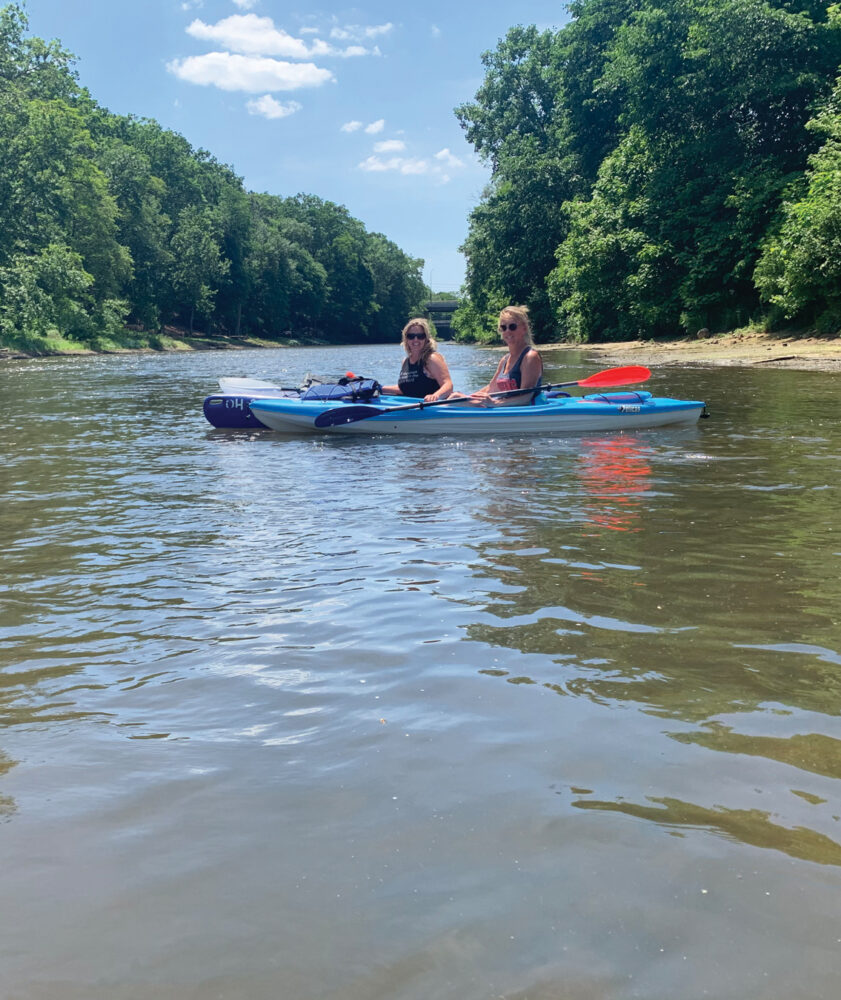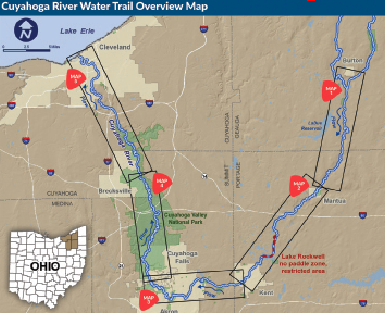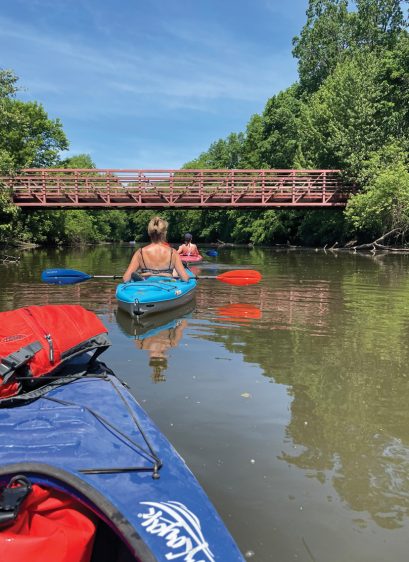From polluted to pleasurable: Cuyahoga River rises to top spot for urban kayaking in U.S.A.
by Emily Chesnic
One Ohio body of water – once too toxic to touch – now entertains paddling enthusiasts especially, even gaining national recognition for it.
More than 50 years ago, the Cuyahoga River caught fire for the 13th time due to flammable pollutants in the water, igniting change. Today, the cleaner, more-user friendly river regularly draws people into the water for recreation.
In March, USA Today deemed the Cuyahoga River the best place in North America for urban kayaking, putting it No. 1 on a top-10 list, with the sport continuing to increase in popularity, specifically among locals.
“The Cuyahoga River has certainly come a long way in recent decades, and with it, designation as an official state water trail, paddling is a great way to enjoy nature and the river itself,” said Stephanie Walton, Summit Metro Parks chief of marketing and communications.
Five decades of cleanup
In 2019, the approximately 100-mile, U-shaped river became a designated water trail in the state of Ohio, an accomplishment numerous agencies and organizations spent years working together to achieve amid ongoing water purification efforts, she said.
National Park Service Outdoor Recreational Planner Andrea Irland said 2019 marked the 50th anniversary of the last river burning, with the trail designation providing tangible evidence of the river’s rejuvenation on that milestone.
“The last fire began an environmental movement, and the Clean Water Act was established. Fifty years later, the river is an official water trail,” she said.
The Cuyahoga River Water Trail, featuring five segments appealing to paddlers of all skill levels, runs through four counties, including Summit and Cuyahoga counties, up to Lake Erie, flowing right through the heart of downtown Cleveland.
“The river provides diverse kayaking experiences central to the Great Lakes and right in the Cuyahoga Valley National Park,” said Devin Pennypacker, manager for Appalachian Outfitters, an outdoor retailer located in the village of Peninsula.
An avid kayaker, Pennypacker said the river has multiple access points now, making it easy for paddlers, like himself, to “jump in the water and go.”
According to the Cuyahoga River Water Trail map, there now are 24 river access points, including in the villages of Burton, Hiram, Peninsula and Boston Township and in the cities of Kent, Munroe Falls, Cuyahoga Falls, Akron and Brecksville, providing segments ideal for beginners and white-water rapids appealing to advanced paddlers.
Pennypacker said it is common to see many paddlers on the river, with some kayakers even driving hours to get to an access point.
“The Cuyahoga River definitely is being used more and more,” he said. “It used to be known for being dirty and hard to get to. Clean up efforts and the removal of dams have made it easier and safer to use, though.”
A team effort
Friends of the Crooked River, an organization of stewards of the Cuyahoga, has been instrumental in removing the dams, leading to less contaminated water, said board member John Kaminski, who joined the organization 30 years ago to help advocate for change.
“The removal of dams has led to increased recreational opportunities,” he said. “In 1990, the river was not even a place to paddle. The bacteria count was extremely high at times and posed a threat to health.”
For almost 200 years, a dam in the Cuyahoga River has diverted water into the Ohio and Erie Canal near Station Road. First was the Pinery Feeder Dam, built in 1827 as part of canal construction. Next was the Brecksville Diversion Dam, completed in 1952 to provide water to the American Steel and Wire Company.
A large-scale effort to better the river’s water quality and impact government regulations is continuing to pay off, however, Kaminski said. Several stretches between Akron and Cleveland – once considered the river’s most polluted section – now meet at least some or all of the goals set by the Clean Water Act.
“To see the Cuyahoga River today, even compared to 10 years ago, is wonderful,” he said. “Amazing partnerships have gotten this done. The river is becoming a great success story because a lot of people at various levels are looking out for it.”
One of those people who continue to care for the river is Bath Township resident Elaine Marsh, a pillar of Friends of the Crooked River, who works “tirelessly” to better water quality, said Irland.
“She is a voice for the river. Right now, she is actively involved in getting the last dam removed, the Gorge Dam,” she said.
To see problems that once existed along the river now fixed is very satisfying for Kaminski, who is pleased the river has become so attractive to paddlers.
“We want to keep drawing attention to the recreational opportunities that exist in the watershed and continue to educate,” he said.
As a child, Kaminski remembers driving along the river, seeing “foam” in it due to high phosphate levels. Now he is readying to kayak the river this summer with his own kids, a new hobby for his family.
Gaining popularity
During the COVID-19 pandemic, paddling specifically became a fresh activity for many, with suppliers unable to keep up with demand, said Pennypacker. Appalachian Outdoors is continuing to sell a record number of kayaks in 2021, he said.
“When COVID hit there was nothing to do but get outside. People began to adore the outdoors. We are fortunate to have the river in our backyard,” said Pennypacker.
The Ohio Department of National Resources recently reported registrations are up 200 percent for non-motorized crafts, including kayaks and canoes, said Irland.
Since so many are using the Cuyahoga River now for recreation, she said efforts are underway to provide even more information to users on how to properly share and navigate through the waterway.
Ryan Ainger, a Broadview Heights native, has been kayaking the river since he was a child. He is now employed as a river ranger with the Cuyahoga Valley National Park, where he’s spent the past eight years putting his passion for the water into service by helping to make the sport more amenable to kayakers of all skill levels.
Because the existing launches are relatively primitive without a lot of amenities, improving the sites – particularly Station Road Bridge – is on the CVNP’s to-do list over the next few seasons, he said.
Ainger, who has frequently kayaked from Brecksville’s Station Road Bridge north to Rockside Road over the years, describes that stretch as “a nice paddle.”
“That’s a particularly calmer stretch of river that is fantastic for beginners and we want to make it even more accessible,” Ainger said.
As the popularity of kayaking has risen throughout the pandemic, Ainger said many of the access points along the Cuyahoga have witnessed significant increase in traffic – some to the tune of 300 percent since 2019.
As those numbers are only expected to grow, he said the CVNP is focused on diversifying transportation options to and from the river.
“You usually have to have someone pick you up or you have to take two cars and park one where you launch and another where you planned to exit the river,” he said, noting that kayakers are now able to paddle and bike the Towpath and even paddle and ride back on the Cuyahoga Valley Scenic Railroad.
Enjoying the scenery
After the last day of school in June, two staff members from Revere Schools took their own adventure on the Cuyahoga River.

Sixth-grade Revere Middle School Teacher Jill Alessandro said this was her first time kayaking on this specific part of the river. She and Revere High School Attendance Secretary, Debbie Zendlo, entered the river at Brust Park in Munroe Falls. They kayaked to Missing Mountain Brewing Company in Cuyahoga Falls for lunch and then continued down the river.
Zendlo said she has kayaked on the Cuyahoga River only a couple times since she purchased her kayaks a few years ago. She usually starts her kayaking journey in Kent and ends at the Water Works Park in Cuyahoga Falls.
“I really enjoy doing it. The scenery is much more diverse than just going to an open lake,” she said.
Zendlo has two kayaks, one for her and one for her husband, but when he is unable to come, she likes to share one of them with a friend or family member who doesn’t have his or her own. On this trip, her daughter Hailee, a 2014 Revere graduate, came along for the adventure.
Alessandro has found another group of kayaking companions through a Meetup group. During outings with these friends, she found new kayaking locations and has spoken to people about their kayak experiences elsewhere.
“I do recommend that kayakers from any skill level get out and explore the river at some point. I am looking forward to visiting other areas of the river for a few more river adventures this summer,” said Zendlo.
Bill Hamilton, of Richfield, said he has been kayaking the Cuyahoga for about 20 years with his friend Kris Gau, of Stow.
He said when they first started they equipped their kayaks with hand saws because back then the National Park Service didn’t clear the trees that fell into the river.

When asked his favorite section of the river to kayak, Hamilton said, “Anywhere my boat can float.”
More details on the water trail, including safety information, can be found at https://cuyahogariverwatertrail.org. ∞

